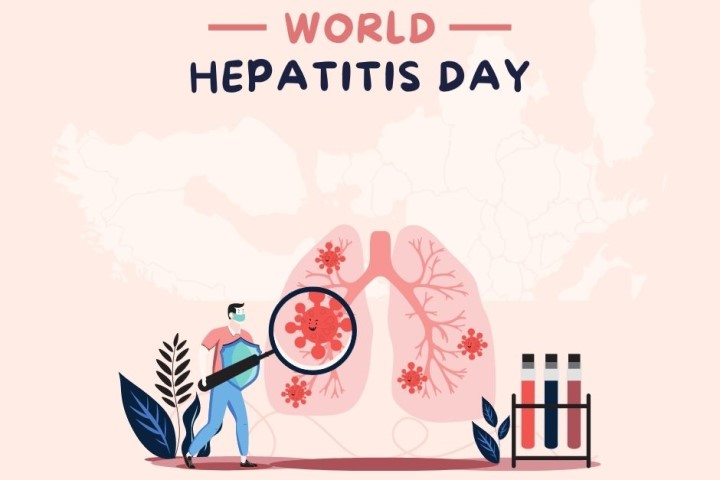World Hepatitis Day is annually commemorated on July 28 to create awareness among people about the viral disease. The hepatitis virus has five primary strains, known as types A, B, C, D and E. They all cause liver disease, but there are key differences between them in terms of origin, transmission and severity.
According to the World Health Organization (WHO), approximately 354 million people in the world are living with hepatitis B and C. For most people testing as well as treatment is beyond reach.
World Hepatitis Day: History
The World Health Organisation launched this campaign with an aim to make the world free of hepatitis. The World Hepatitis Alliance was founded in the year 2007 and the first community-organised World Hepatitis Day was observed in 2008.
In 1967 American Physician Baruch Samuel Blumberg discovered the Hepatitis B virus. In order to honour the Nobel Prize-winning scientist his birthday, July 28, was chosen as World Hepatitis Day. Samuel Blumberg discovered hepatitis B and invented a test as well as vaccination for the same.
World Hepatitis Day 2022: Theme
This year’s theme for World Hepatitis Day is, ‘Bringing hepatitis care closer to you.’ The idea of this theme is to focus on raising awareness of the need to make hepatitis care more accessible.
HEPATITIS A
- Hepatitis A is an inflammation of the liver that can cause mild to severe illness.
- The hepatitis A virus (HAV) is transmitted through ingestion of contaminated food and water or through direct contact with an infectious person.
- Almost everyone recovers fully from hepatitis A with a lifelong immunity. However, a very small proportion of people infected with hepatitis A could die from fulminant hepatitis.
- The risk of hepatitis A infection is associated with a lack of safe water and poor sanitation and hygiene (such as contaminated and dirty hands).
- A safe and effective vaccine is available to prevent hepatitis A.
HEPATITIS B
- Hepatitis B is a viral infection that attacks the liver and can cause both acute and chronic disease.
- The virus is most commonly transmitted from mother to child during birth and delivery, as well as through contact with blood or other body fluids during sex with an infected partner, unsafe injections or exposures to sharp instruments.
- WHO estimates that 296 million people were living with chronic hepatitis B infection in 2019, with 1.5 million new infections each year.
- In 2019, hepatitis B resulted in an estimated 820 000 deaths, mostly from cirrhosis and hepatocellular carcinoma (primary liver cancer).
- Hepatitis B can be prevented by vaccines that are safe, available and effective.
HEPATITIS C
- Hepatitis C is an inflammation of the liver caused by the hepatitis C virus.
- The virus can cause both acute and chronic hepatitis, ranging in severity from a mild illness to a serious, lifelong illness including liver cirrhosis and cancer.
- The hepatitis C virus is a bloodborne virus and most infection occur through exposure to blood from unsafe injection practices, unsafe health care, unscreened blood transfusions, injection drug use and sexual practices that lead to exposure to blood.
- Globally, an estimated 58 million people have chronic hepatitis C virus infection, with about 1.5 million new infections occurring per year. There are an estimated 3.2 million adolescents and children with chronic hepatitis C infection.
- WHO estimated that in 2019, approximately 290 000 people died from hepatitis C, mostly from cirrhosis and hepatocellular carcinoma (primary liver cancer).
- Antiviral medicines can cure more than 95% of persons with hepatitis C infection, but access to diagnosis and treatment is low.
- There is currently no effective vaccine against hepatitis C.
HEPATITIS D
Hepatitis D virus (HDV) is a virus that requires hepatitis B virus (HBV) for its replication.
- Hepatitis D virus (HDV) affects globally nearly 5% of people who have a chronic infection with hepatitis B virus (HBV).
- HDV infection occurs when people become infected with both hepatitis B and D simultaneously (co-infection) or get hepatitis D after first being infected with hepatitis B (super-infection).
- Populations that are more likely to have HBV and HDV co-infection include indigenous populations, recipients of haemodialysis and people who inject drugs.
- Worldwide, the number of HDV infections has decreased since the 1980s, due mainly to a successful global HBV vaccination programme.
- The combination of HDV and HBV infection is considered the most severe form of chronic viral hepatitis due to more rapid progression towards liver-related death and hepatocellular carcinoma.
- Hepatitis D infection can be prevented by hepatitis B immunization, but treatment success rates are low.
HEPATITIS E
- Hepatitis E is an inflammation of the liver caused by infection with the hepatitis E virus (HEV).
- Every year there are an estimated 20 million HEV infections worldwide, leading to an estimated 3.3 million symptomatic cases of hepatitis E.
- WHO estimates that hepatitis E caused approximately 44 000 deaths in 2015 (accounting for 3.3% of the mortality due to viral hepatitis).
- The virus is transmitted via the fecal-oral route, principally via contaminated water.
- Hepatitis E is found worldwide, but the disease is most common in East and South Asia.
- A vaccine to prevent hepatitis E virus infection has been developed and is licensed in China, but is not yet available elsewhere.
5 actions to protect yourself against hepatitis:
- Use sterile injections always
- Use your own razors and blades
- Practise safe sex
- Use safe tattooing and piercing equipment
- Vaccinate infants against Hepatitis B




